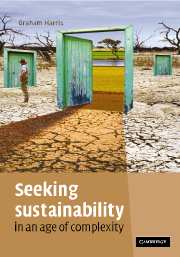Book contents
- Frontmatter
- Contents
- Acknowledgements
- 1 Preamble: the world we are in
- 2 Complexity and complex systems
- 3 New science, new tools, new challenges
- 4 The complexity of ecology
- 5 The generation of complexity
- 6 Micro-interactions and macro-constraints
- 7 A sense of place
- 8 Created landscapes and our changing sense of place
- 9 Catchment form and function
- 10 Catchment loads: ecosystem impacts
- 11 Change detection, monitoring and prediction
- 12 Evidence, uncertainty and risk
- 13 Modified landscapes: biodiversity
- 14 Function in fragmented landscapes
- 15 Environmental flows
- 16 Evidence for global change
- 17 Values and beliefs
- 18 Managing environmental, social and economic systems
- 19 Linking multiple capitals in a changing world
- 20 Community, capacity, collaboration and innovation
- 21 A new environmental paradigm
- 22 Emergent problems and emerging solutions: developing an ‘ecolophysics’?
- 23 Avoiding collapse
- Index
10 - Catchment loads: ecosystem impacts
Published online by Cambridge University Press: 21 March 2011
- Frontmatter
- Contents
- Acknowledgements
- 1 Preamble: the world we are in
- 2 Complexity and complex systems
- 3 New science, new tools, new challenges
- 4 The complexity of ecology
- 5 The generation of complexity
- 6 Micro-interactions and macro-constraints
- 7 A sense of place
- 8 Created landscapes and our changing sense of place
- 9 Catchment form and function
- 10 Catchment loads: ecosystem impacts
- 11 Change detection, monitoring and prediction
- 12 Evidence, uncertainty and risk
- 13 Modified landscapes: biodiversity
- 14 Function in fragmented landscapes
- 15 Environmental flows
- 16 Evidence for global change
- 17 Values and beliefs
- 18 Managing environmental, social and economic systems
- 19 Linking multiple capitals in a changing world
- 20 Community, capacity, collaboration and innovation
- 21 A new environmental paradigm
- 22 Emergent problems and emerging solutions: developing an ‘ecolophysics’?
- 23 Avoiding collapse
- Index
Summary
Human interference in catchment and the ecosystem responses: titrating ecosystems with nutrients. Non-linear responses and thresholds.
Despite the fractal properties of the linkages between catchments and rivers, the tendency in almost all the work on land use and nutrient loads to receiving waters has been to use large-scale and long-term averages of water quality data collected in rivers and streams to assess downstream impacts. This is partly because of two fundamental biases and misconceptions: first, that the usual regime of weekly or more infrequent sampling is sufficient, and second, that the observed variability in the data is just noise, which can be averaged and dealt with statistically. Recent analysis of high-frequency data from rivers, lakes and coastal waters (and by high-frequency I mean data collected daily or even more frequently than that – down to minutes in some cases) indicates that both these basic assumptions are false. The data are not just ‘noisy’, there is information there, and weekly or less frequent sampling does not resolve the true scales of pattern and process. In short, catchments have fractal flow paths and these produce fractal distributions of patches of water flowing down rivers and into receiving waters. The species that characterise both terrestrial and aquatic ecosystems interact to both produce and exploit these fractal patterns; they are part and parcel of the reaction–diffusion relationships between organisms at small scales.
- Type
- Chapter
- Information
- Seeking Sustainability in an Age of Complexity , pp. 127 - 139Publisher: Cambridge University PressPrint publication year: 2007

